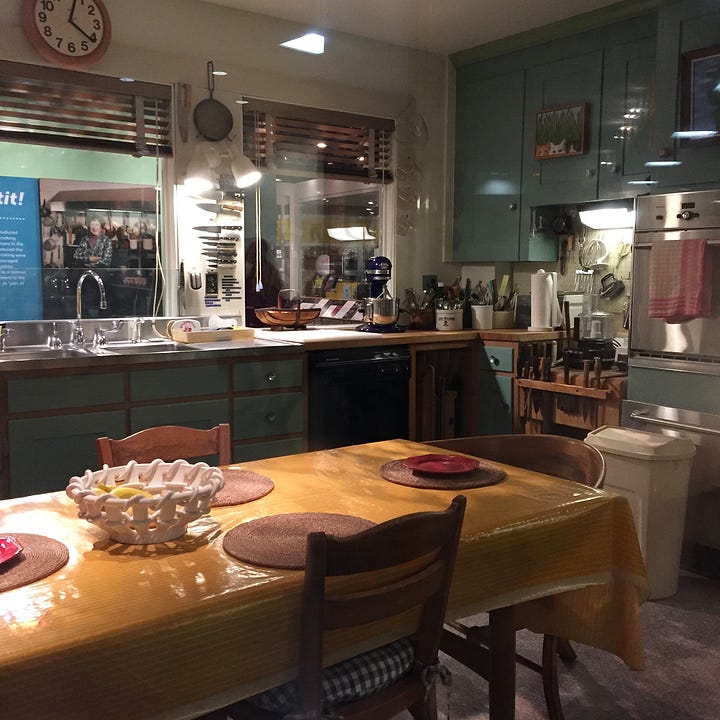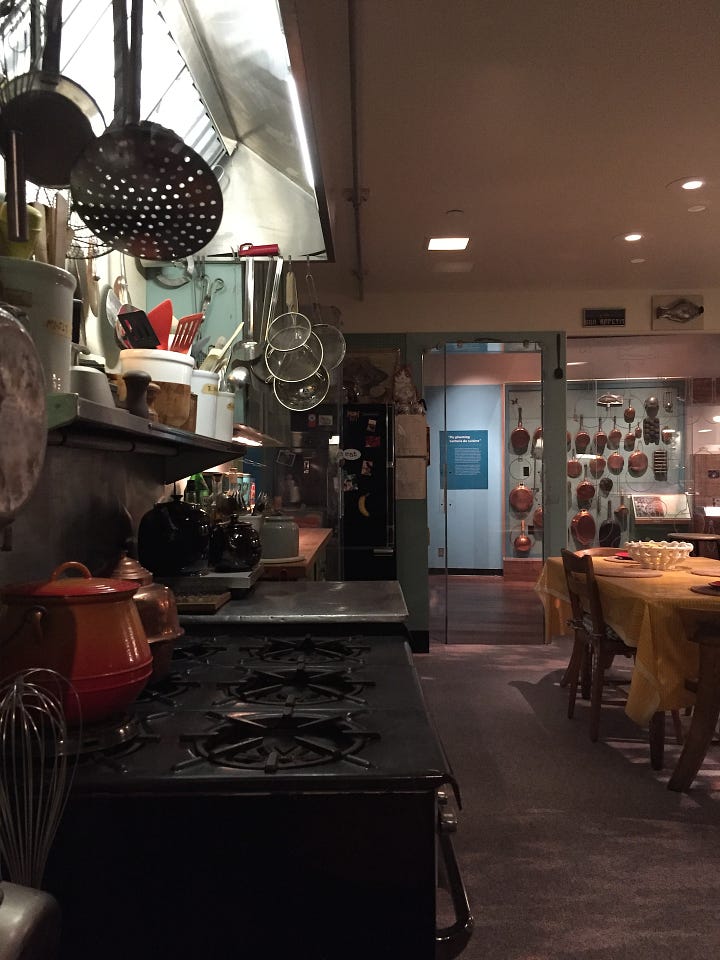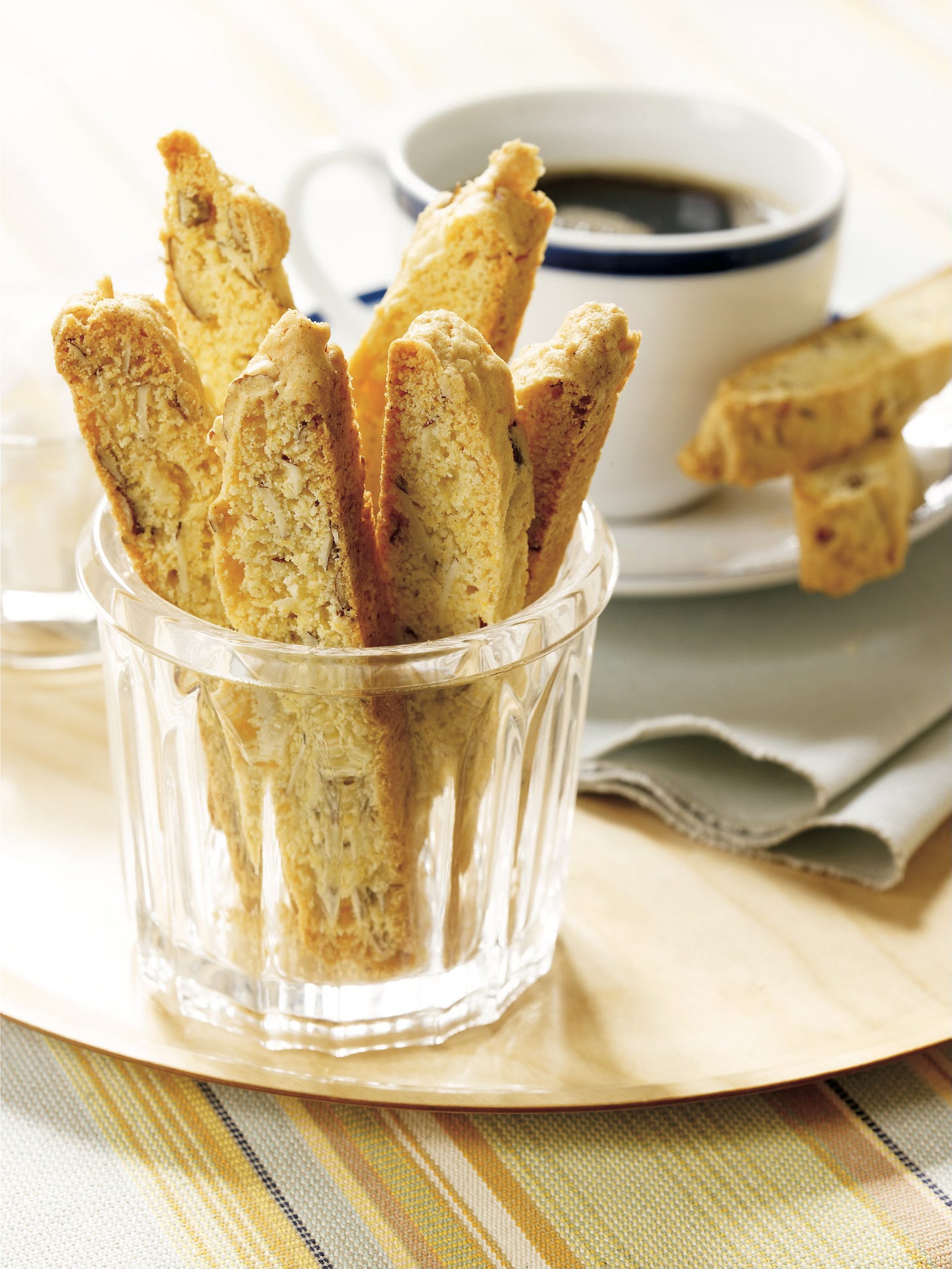A to-do list for the new year: scrape the bowl, save the scraps and raise a glass
Plus, a recipe for biscotti that honors a dear friend (and adds "dunk a cookie" to your to-dos)
Hello! Hello!
Sweet wishes for the New Year from me here to all of you there.
2023 ended in tumult for millions and 2024 doesn’t look as though it’ll be a walk in the park. All the more reason to hold on to the love we have and to seek out moments when we can to be kind and open-spirited. To help one another when we can and to think of one another always.
If only everyone were as lovely as you, dear readers of xoxo and bakers of Bake and Tell. Thank you for being here, for being with each other and for creating a cocoon of kindness.
Today, I’ve got a trio of vignettes about a trio of friends. And there’s a recipe for my favorite biscotti. I hope you’ll bake and share them with people you care about.
Be Like Julia: Clean the Bowl
I think of Julia (Child, that is) so often — even more often now that I’m watching Julia on MAX and listening to the podcast, Dishing on Julia — and I think of her every time I bake, which is almost daily.
When I was in Julia’s home for the shooting of the tv series, Baking with Julia (I later wrote the book of the same title), Julia would be in her kitchen every morning with a different chef and we’d film the two of them baking in real time. While there were swaps — Steve Sullivan from Acme Bakery had a bunch of sourdough starters rising (and sometimes overflowing) in different places in and out of the house — there was never a time when we didn’t shoot a recipe from start to finish. And there was never a time when a chef scraped a bowl to Julia’s satisfaction. The chef would be working away, Julia would be next to her or him, and when the chef was done with a pot or a bowl, he’d just reach back and drop it in the sink. The bowl would barely have time to land before Julia would reach back, grab it and give it a good look. And then, like a teacher admonishing an errant school child, she’d turn the bowl to the chef, pick up a spatula and say: Look at all the batter that’s left! There might have been a tsk-tsk or two before she scraped out the remains and dumped them into the baking pan with a gesture as broad as a house beam.
Julia was thrifty that way. And so was her cooking buddy, Jacques Pépin.




Be Like Jacques: Save the Scraps
I had mentioned to Jacques Pépin that the first time I went into a big-time restaurant kitchen, I watched prep cooks work with bell peppers. They’d trim the tops and bottoms, cut the peppers lengthwise to clean away the spines and seeds, and then cut the bodies into strips or cubes. It was beautiful to watch until I saw the cooks sweep the scraps into the garbage. It was the same with the onions and radishes, mushrooms, celery and more — everything went into the trash. I asked Jacques why they weren’t saving the vegetable bits and he chuckled.
He told me that he’d been just as shocked when he came to America as a young cook, because in France, where he was born, at home and in professional kitchens, every last bit of everything was saved and used. When he asked his first NY chef why they threw away good food, here’s the answer he got: In France, ingredients are expensive, so you make the most of them. In America, labor is expensive, so we can’t take the time to think about leftovers and scraps.
Jacques’s experience was 60 years ago, mine not new, but more recent.
I’m wondering — for those of you who work in professional kitchens, is this still the case? And what about you who cook and bake at home, what do you do? I’m curious. Chez moi, I save what I can for soups and stocks and compost what I can’t. I love composting!

Raise a Glass and Dunk a Cookie
Last week, my friend Tony Fortuna, once crowned the best new maitre d’hotel, died. You may not have known him — he wasn’t famous in the way many people in food are today — but he helped make other people famous and, more important, he helped make New York a better place. He had a gift for graciousness and an uncanny ability to put everyone at ease. As Florence Fabricant said in her New York Times obituary, Tony “turned running a dining room into a fine art as a consummate host.” And he was brilliant at friendship. I know because he befriended me and my family almost 40 years ago. Here’s how I met him.
It was October 1986 and Restaurant Lafayette had opened less than six months before. The chef was Jean-Georges Vongerichten, a 29-year old newbie to New York, and the maître d’ was Tony Fortuna. It was a splurge restaurant — especially for us — but Michael and I went there with another couple to celebrate our birthdays that year. While none of us was used to such fancy places — I think Tony figured that out in a flash — it didn’t take long for us to feel so comfortable that we laughed and talked nonstop the way we would have at home. Everything was startlingly delicious, and we felt so special … until dessert. We had watched with anticipatory glee as the elaborate dessert cart — that’s how luxe desserts were presented in those days — made its rounds, and we fidgeted when it was our turn and the cart didn’t come. Just when we thought we’d been forgotten, every server in the restaurant came to our table, each holding a spectacular dessert. It was astounding and we were astonished when Tony said: This is how we celebrate birthdays at Lafayette! As Tony moved everything around on our table to make room for the abundance of sweets, we asked him how he could possibly have known. “When I came to the table with the menus, you were finishing a conversation about your birthdays. I couldn’t help but hear.”
That was Tony’s style. And that was the start of our friendship. It was also, thanks to Tony, the start of my career. A story for another time.

For now, I’m finding joy in talking to Michael, Joshua and friends about all the extraordinary moments we shared with Tony, most of them made extraordinary by him, and in baking the biscotti we loved. Tony used to serve these at Lenox Room, the first restaurant that was all his in New York, and because he knew how much we liked them, he used to send us home with some. Finally, he gave me the recipe (it’s in Baking: From My Home to Yours) — scroll down to grab it for yourself. And if you make them, would you please dunk them (dunking them in vin santo would be most traditional) and raise your glass to Tony.
Grazie mille, Tony.
LENOX ALMOND BISCOTTI
With thanks to Tony Fortuna
Adapted from Baking: From My Home To Yours

Makes about 30 cookies
INGREDIENTS
1 1/2 cups (204 grams) all-purpose flour
1 1/2 teaspoons baking powder
1/4 teaspoon fine sea salt
1/2 cup (72 grams) yellow cornmeal
8 tablespoons (4 ounces; 113 grams) unsalted butter, at room temperature
1 cup (200 grams) sugar
2 large eggs, at room temperature
1 1/2 teaspoons pure almond extract
3/4 cup (75 grams) sliced almonds, blanched or unblanched
DIRECTIONS
Center a rack in the oven and preheat it to 350 degrees F. Line a baking sheet with parchment paper or a silicone mat.
Whisk the flour, baking powder and salt together. Add the cornmeal and whisk again to blend.
Working with a stand mixer fitted with a paddle attachment, or with a hand mixer in a large bowl, beat the butter and sugar together at medium speed for 3 minutes, until very smooth. Add the eggs and continue to beat, scraping down the bowl as needed, for another 2 minutes, or until the mixture is smooth and creamy. Beat in the almond extract. Reduce the mixer speed to low and add the dry ingredients, mixing only until they are incorporated. You’ll have a soft stick-to-your-fingers dough that will ball up around the paddle or beaters. Scrape down the paddle (or beaters) and bowl, toss in the almonds and mix just to blend.
Scrape half the dough onto one side of the baking sheet. Using your fingers and a spatula or scraper, work the dough into a log about 12 inches long and 1 1/2 inches wide. The log will be more rectangular than domed, and bumpy, rough and uneven. Form a second log with the remaining dough on the other side of the baking sheet.
Bake for 15 minutes, or until the logs are lightly golden but still soft and springy to the touch. Transfer the baking sheet to a rack and cool the logs on the sheet for 30 minutes.
If you turned off the oven, bring it back up to 350 degrees F.
Using a wide metal spatula, transfer the logs to a cutting board and, with a long serrated knife, trim the ends and cut the logs into 3/4-inch-thick slices. Return the slices to the baking sheet – this time standing them up like a marching band – and slide the sheet back into the oven.
Bake the biscotti for another 20 minutes or so, or until they are golden and firm. (A note from me 18 years later — the original recipe called for this bake to be 15 minutes, but now I don’t think that’s enough. Check the cookies at 15 minutes and decide if you’d like them firmer and darker.) Transfer the biscotti to racks and cool to room temperature.
STORING: Because they are dry and they’re fine if they get even drier, the biscotti will keep at room temperature, covered or not, for about a week. They can be wrapped well and frozen for up to 1 month. Thaw them in the wrapper and then, if they need it, give them a few crisp-up minutes in the oven.
Some of the links in this post may be affiliate links. As an Amazon Associate and Bookshop.org Affiliate, I might earn a little flour-and-sugar money if you make a qualifying purchase after clicking on a link, which I promise to use while creating more stories like this. Thanks for your support. You can find more “Off the Shelf” book recommendations here.
📚 You can find more recipes in my latest book BAKING WITH DORIE.
👋 Say hello and share what you're making on Facebook and Instagram.







Loved your writing on kitchen scraps! They're definitely being thrown away more often now in French restaurant kitchens, which are operating more like American ones.
But I've also worked in the kinds of places whose flattop held a single huge stockpot, into which were thrown meat and veg scraps (not peels!) all week long. The flavor of the stock intensified over the course of the week as it bubbled away with the merest of simmers.
These kitchens are now more rare in France, but food thrift is making a comeback. L'espoir fait vivre!
Thank you for another terrific post and recipe! I am an avid gardener and all of my fruit and vegetable scraps go into the freezer for stock or into the compost pile. I also use fruit scraps to make fruit vinegar. Apple peels and cores for apple cider vinegar and pineapple scraps for pineapple vinegar. These vinegars are great for deglazing a pan. Meat bones and scraps are used for stock.